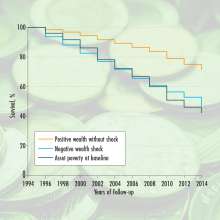Walking along the Marshland trail, half a kilometer from the junction of Bath Road and Johnson, Kingston, I stop to gaze at a sweep of golden yellow lilies. Known as Trout Lilies, Dogtooth Violets, Adder’s Tongues, the mottled sword-shaped leaves add to the beauty of the pretty petals hanging down contemplating the shortness of their lives.
Although I’m entranced by the symmetry and abundance of these precious spring flowers, a note of sadness accompanies my enchantment. I realize that for 30 years, I’ve seen them suddenly appear in April or May and just as suddenly droop, die and disappear as though they were never really in the woods but only in my mind.
Some acquaintances, who have seen them, speak with excitement of the Adder’s Tongues and other wild flowers. Their eyes light up. No inkling do they reveal that sad and dark thoughts were evoked by the spring flowers. They perceive a yellow Elysium meadow that enthrals them.
During the first week of May, while wheel chairing my love around the grounds of Trillium Centre (long-term care home), my attention turned to a steep bank separating the buildings from a little park. The numerous dandelions were a riot. They seemed to be in rows and stretched for more than a hundred metres. Again my sadness diluted the beauty. I thought of crosses row on row marking the graves of the fallen in wars innumerable. Deep down I felt that these dandelions were perishing even as they bloomed.
Two days later, the dandelions were cut down by a mower. Though workers erased the flowers, via memory the image stays with me--that of life quickly being followed by death. Like the flowers of the field, we, too, flourish then perish.
Leo Rosten, in his book The Story behind the Painting, insists that we see things as we are, not as they are. What we perceive and how we feel about it has a lot to do with our mood at the time of encounter with wildflowers or any other nature scenes, artistic expressions, or persons we meet.
When I visit a hospital, I sense that the emphasis is on healing people and getting them out. But in long-term care visits, the emphasis is on comfort and care. I’ve been living with the dying as a regular visitor for over two years. There is only one way out for most residents and that is to pass away.
As I’m in the atmosphere where there is no Pandora’s Box with hope at the bottom, I realize that none of us can escape death or thinking of death. Although, we often try to ignore the skeleton in the room, it nevertheless is always present. We can try to forget about death and dying but deep inside as we grow old we surmise secretly that we’re all condemned to die.
Eleanor Campbell, my mother-in-law long deceased, never liked geraniums. She wouldn’t have one in the house and didn’t like visiting others with these plants in their homes. She connected her abhorrence of geraniums with the smell of the geraniums that filled the little church at her mother’s funeral years ago. For the rest of her life, she associated geraniums with her mother’s death. The sight and smell of this plant made her relive the sorrow and sadness of the passing away of her dear mother.
In the Bible, images of flowers speak of the cycle and brevity of life. Psalm 103:15: “As for mortals, their days are like grass; / they flourish like a flower of the field; / for the wind passes over it and it is gone.” Isaiah (28: 1) refers to the “fading flower” and its “glorious beauty.”
In the Song of Solomon (2:12 ff) notes that winter is past and the cycle continues as flowers appear on the earth and fragile as they are they soon pass away. In (James 1: 10) I read of the passing away of flowers as an illustration of what happens to the rich: “The sun rises with its scorching heat and withers the field; its flower falls and its beauty perishes.”
We are all involved in the cycle of life and death. When we were young, most of us spent little time thinking about death. But as we age, we realize that people including us, pass away. The obituaries in the newspapers, the funerals of our friends, the decline of our bodies and minds—make us face up to our own end as well as that of others. When we try to deny the obvious, we lodge death in the subconscious where it continues to affect our feelings and thoughts in an unhealthy way.
Dr. Frank Bannister had us read this line in a class of Practical Theology at Queen’s: “These flowers were beautiful, but now they are faded” When my turn came, my emotional state shifted in a split second from the beauty of life to the grisliness of death.
Try this exercise by first getting the impression of the beauty of the flower, then expressing how it makes you feel. Shifting to an impression of the faded flowers and as you say the words, you will become aware, as I did, of the cycle of life and death, of beauty and its loss. No matter how fresh and beautiful the flowers are, they soon fade and pass away.
The meaning we make of our lives destined to pass away, poses the primary problem for thinking persons. Some opt to deny the finality of life by fashioning paradise, heaven, eternal life, resurrection, nirvana, happy hunting grounds. This option I see as a comforting denial of the finality of death. Then, again, it can be seen as the outcome of our alleged hardwiring for life beyond death. Whether we see death as the end of life, or the beginning of another form and state of life, we should be humble about our position. For no significant evidence so far exists to validate either option.
While the song, “Old soldiers never die / they only fade away,” is a cute little ditty, the truth is that old soldiers, like all persons, critters and flowers, both fade away and pass away. Knowing this, I find it provides an incentive to live life to the fullest. For the saying “this too will pass,” fails to apply to fading and dying.

